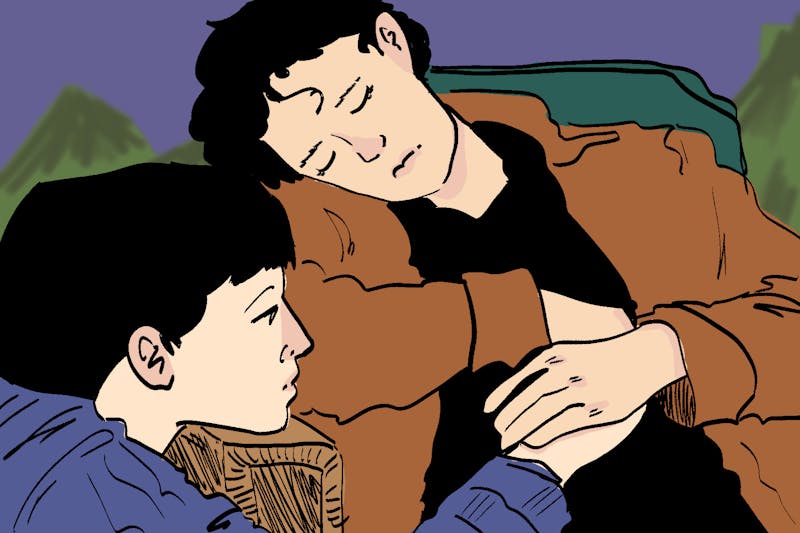On Oct. 21, students, faculty and community members gathered in Loew Auditorium to watch Swiss director Fredi Murer’s 1985 film, “Alpine Fire.” The screening was part of Cannes on the Connecticut, a film series curated by Montgomery Fellow Vinzenz Hediger to showcase international films.
“For Swiss cinema, it’s a very significant film because it’s one of the few that broke through internationally,” Hediger said in an interview with The Dartmouth. “It won a lot of awards and it was extremely well-received not only because it was a very daring film, but also a film that was done with a lot of restraint, using cinema in a very effective way without going for spectacle and without investing a whole lot of money.”
A former film critic for Switzerland’s largest newspaper, “Neue Zürcher Zeitung,” and now a professor of cinema studies at Goethe University Frankfurt, Hediger said he selected Alpine Fire because of its lasting presence in the Swiss film canon.
“I was asked to put together a list of essentials, and this was very much at the top,” he said. “It is generally considered to be the most original film ever made in Switzerland — one of the best films ever made in Switzerland.”
In “Alpine Fire,” Murer captures the isolated life of a family living on a mountain farm in Switzerland over the course of a year. Through sweeping shots of the Alps and carefully observed daily routines, the film offers a striking portrait of rural existence defined by hard work, silence and natural beauty. Though deliberately slow, the pacing never drags; instead, it draws the viewer into the family’s rhythm. Music is used sparingly, allowing silence and natural sounds to speak louder than any score could. We begin to feel the repetition of their chores, the turning of the seasons and the deep quiet that fills their days, placing us in the shoes of people whose lives move at the pace of nature itself.
Perhaps that’s what makes the film so deeply unsettling. Beneath its serene landscapes and gentle rhythm, “Alpine Fire” hides a story of profound psychological tension: an incestuous relationship between a brother and sister. Murer approaches this deeply uncomfortable material not with shock or judgment but with restraint and empathy, forcing the viewer to sit with moral unease rather than recoil from it. The result is a haunting look at how isolation can twist the most human desire for connection into something tragic.
The film’s emotional core rests on Bub, the family’s deaf teenage son, whose close relationship with his sister Belli eventually crosses boundaries and becomes the film’s central conflict. He is the film’s most complex figure — emotionally layered yet trapped in a body and world that offer him no language for what he feels. His deafness isolates him, leaving him to interpret the world through movement and light, while his constant use of lenses — eyeglasses, mirrors, binoculars — becomes both a means of communication and a metaphor for his futile search for connection. Bub’s frustration manifests in physical acts throughout the film: his decision to throw the mower off a cliff, his obsessive rock-building and his increasingly fraught relationship with Belli. These moments of quiet rebellion against his circumstances give the film its rawest impact and, in their own way, offer the most grounded insight into how such a transgression could occur.
For all its beauty and restraint, “Alpine Fire” is not without its flaws. Its slow pacing, though immersive, occasionally drifts into unevenness, and certain narrative choices blur the line between empathy and endorsement. That imbalance is most apparent in a later scene where the film’s quiet approach feels at odds with what it depicts. An innocent childhood flashback of Belli and Bub lying together is placed directly before a scene of unwanted sexual contact, creating a jarring shift that leaves the viewer uncertain of Murer’s intent. At times, his tenderness toward the characters risks romanticizing their relationship, sending morally mixed signals that undercut the film’s otherwise sharp exploration of isolation and desire. His restraint, admirable for much of the film, occasionally slips into ambiguity that feels less deliberate than evasive.
“Alpine Fire” is not an easy film to watch or to forget. It is psychologically grueling, forcing viewers to sit with discomfort rather than escape from it. Yet its beauty is undeniable. Murer’s breathtaking cinematography turns the Swiss Alps into both a sanctuary and a prison for the family, a landscape that mirrors their emotional confinement as much as their physical one. Despite its flaws, “Alpine Fire” stands as a striking achievement in film — an unnervingly human portrayal of isolation that dares us to find empathy in the most unsettling of places.
